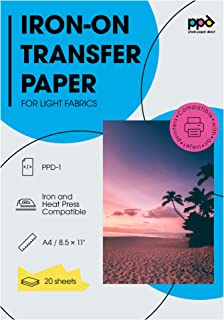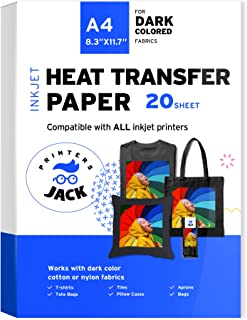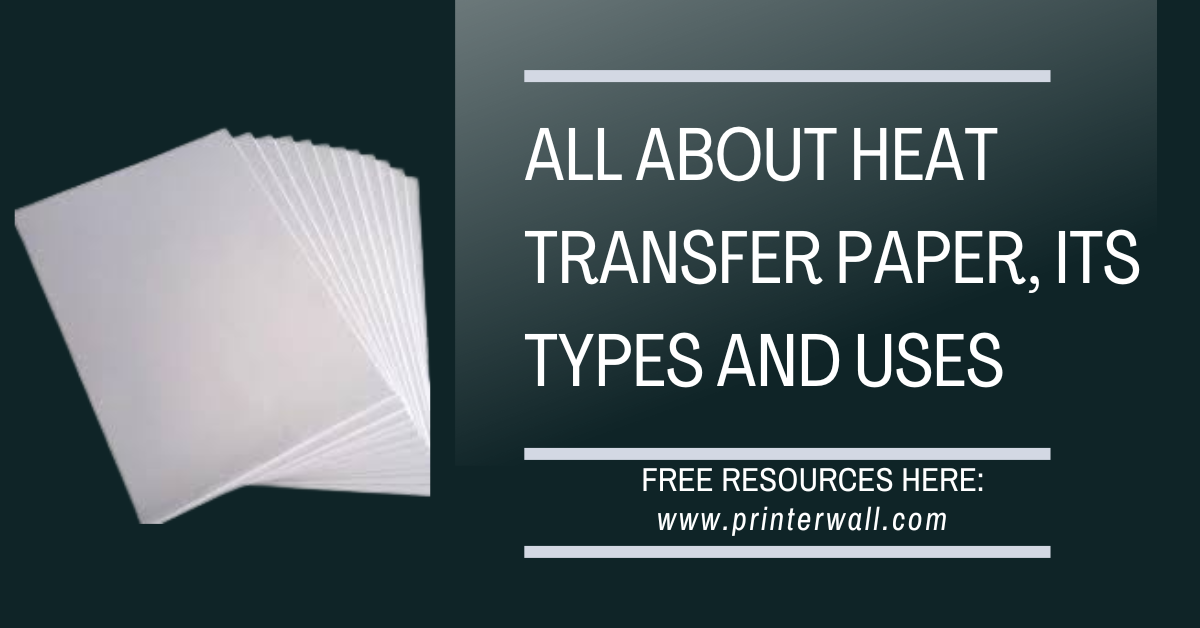It’s pretty likely that you have used heat transfer vinyl if you often use a heat press at home or in your place of business (HTV). You might not have had the chance to deal with heat transfer paper, though. Printing full-color graphics on heat transfer paper enables you to use a heat press to apply them to clothing.
A new product raises fresh queries. What’s the difference, for instance, between bright and dark heat transfer paper? Exists special paper for inkjet or laser printers? What about sublimation, though? These and other inquiries are what we’d want to respond to! You’ll learn all there is to know about best heat transfer and sublimation paper in this blog post and its companion video, which will help you decide which product will best meet your needs.
What is heat transfer paper?
Consider heat transfer paper to be a form of fabric sticker that can be applied to 100% natural-content fabrics after being printed with any pattern on the paper using a home inkjet printer. By pressing it with a heat press or a hand iron, the paper’s unique heat transfer technology uses heat to attach your printed pattern to your fabric.
Common Types of Heat Transfer Paper
Heat Transfer Paper Light

This style is only suitable for light-colored textiles since the background fabric colour will show through your transfer. You must reflect your image before printing it on light-colored heat transfer paper.
Heat Transfer Paper Dark

Given that the backdrop is less visible in this form, it may be applied to dark materials. This one doesn’t technically require you to mirror your picture, but if your print is complex, you might want to think about using transfer tape that can endure heat to properly transfer your design to your cloth.
How to Use Heat Transfer Paper
Are you eager to see how I apply heat transfer paper to a variety of surfaces? The following sentences include all the information you require.
How to Use Heat Transfer Paper Light
The general instructions for employing light heat transfer paper are provided below. To be sure the instructions are the same, always check the package or website for the brand you purchase.
- Print on the sheet’s matte side. Typically, a mark is placed on the side that shouldn’t be printed on. Before printing, be sure to reflect your design. For optimum effects, be sure you print on high-quality paper.
- Cut the design out. For this, you may either cut using scissors or a Cricut machine. While a little white around the margins is OK, I prefer to get rid of as much as I can. If you use a Cricut cutting machine, trim away any extra material from the cut lines.
- Press the fabric briefly to eliminate any moisture and creases before applying your design.
- After that, iron your fabric with your picture facing up at the time and temperature recommended for the product you’re using. You should also check to determine how much pressure your press needs to exert. Since I used an EasyPress for all of my experiments, a heat press will also function with it. It’s likely that an iron will also work, but in that case, be sure to look up any further pressing instructions.
- The backing paper will then be peeled aside to show your artwork. Verify the directions to determine if it needs to cool before being removed.
- While still warm, the cloth may be gently stretched for a softer finish on your finished product.
How to Use Heat Transfer Paper Dark
Let’s examine the requirements for using dark heat transfer paper. Once more, make sure the instructions are the same by checking the box or website for the brand you purchase.
- Print on the sheet’s matte side. Typically, a mark is placed on the side that shouldn’t be printed on. Be careful not to replicate your design. For optimum effects, be sure you print on high-quality paper.
- Cut the design out. For this, you may either cut using scissors or a Cricut machine. With this one, keep in mind that any white that is left over will show in the finished product. If you use a Cricut cutting machine, trim away any extra material from the cut lines.
- Press the fabric briefly to eliminate moisture and wrinkles before applying your design.
- Remove the backing paper from the image and put it on your shirt. Use transfer tape to hold the pieces in place if your design consists of several sections. Before pressing, cover the design with protective paper.
- Apply pressure at the specific time and temperature for the product you are using. You should also check to determine how much pressure your press needs to exert. Since I used an EasyPress for all of my experiments, a heat press will also function with it. It’s likely that an iron will also work, but in that case, be sure to look up any further pressing instructions.
- To reveal your design, remove the shielding paper. Verify the directions to determine if it needs to cool before being removed.
- While the cloth is still warm, you may gently stretch it for a softer feel on your finished product.
How Well Does Heat Transfer Paper Hold Up?
You should pay attention while I do tests on several heat transfer products right now. Should you utilise heat transfer paper for your projects now that you know how to use it? Keep reading to learn more about how it performs and how it stacks up against other heat transfer materials. That video and post are not ones you want to miss!
What’s the best type of fabric to use with heat transfer paper?
You need to transfer to fabric made entirely of natural fibres. For instance, cotton, linen, or silk. On polyester materials or fabrics with flexible components, such lycra or spandex blends, the heat transfer paper will NOT adhere effectively. To prevent stretching after the transfer is fused on, pre-wash your fabric before usage. Give your cloth a brief iron after it is clean and dry before putting the heat transfer paper on it. Do you want to know what your fabric’s content composition is? You only need to look at the fabric tag on the apparel to learn the composition, such as whether it is 100% cotton or 100% linen.
Final Words
Find out when to use heat transfer paper as your decorative approach in our guide to its capabilities and uses now that the mechanism of heat transfer is no longer a secret. You’re still undecided. Explore the distinctions between heat transfer and dye sublimation and between heat transfer and screen printing in more detail. To identify the ideal decorating type for your application, be sure to review our comprehensive Custom Decoration Methods Guide.
Frequently Asked Questions
What type of paper do you use for heat transfer?
Transparent heat transfer paper is used for light fabrics, and white heat transfer paper is used for dark fabrics. Although it may also be used on other very light coloured fabrics, transparent or clear heat transfer paper is often used on white fabrics.
Can you use a regular printer to print on heat transfer paper?
On inkjet heat transfer paper, regular printer ink is indeed acceptable. You can use original or compatible inks. The capacity to last longer gives pigment-based inks a modest edge over dye-based inks. Additionally, an inkjet printer does not need to be modified in order to work with heat-transfer paper.
Do you need sublimation ink for transfer paper?
The immediate response is No, says seasoned sublimation worker Charles. Sublimation ink cannot be used on ANY transfer paper for dark textiles. The most fundamental fact of sublimation is that the polyester fibre is dyed. The picture is not, in contrast to ink on transfer paper.
How long do transfer paper shirts last?
When used in conjunction with a home iron, they will hold up for seven to ten washings. If a heat press is employed, they can withstand 10 to 15 washings.
Which lasts longer screen printing or heat transfer?
Multiple-color patterns can make this process take longer, but screen-printed artwork often lasts considerably longer than heat-pressed artwork.
Wrapping Up
In conclusion, heat transfer paper is a versatile and invaluable tool in various industries and creative endeavors. Its ability to transfer images, designs, and text onto a wide range of surfaces has made it a popular choice for businesses, artists, and DIY enthusiasts alike. We have explored the different types of heat transfer paper, including inkjet, laser, and sublimation transfer paper, each with its unique set of characteristics and applications.
Whether you’re looking to create custom apparel, promotional items, personalized gifts, or art projects, heat transfer paper offers a convenient and cost-effective solution. Its ease of use and compatibility with different printing methods have made it accessible to people of all skill levels.
Additionally, we’ve discussed the diverse applications of heat transfer paper, from producing branded merchandise to decorating ceramics and textiles. Its role in the world of commercial printing and the creative arts continues to expand as technology advances and new possibilities emerge.
As we move forward, it’s evident that heat transfer paper will remain a fundamental tool in the world of customization and personalization. Its potential to transform everyday objects into unique, customized creations makes it an exciting resource for those seeking to express themselves and leave a lasting impression through their work. So whether you’re a business owner, an artist, or a hobbyist, heat transfer paper is a medium worth exploring for your creative and promotional needs.
